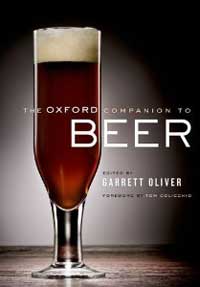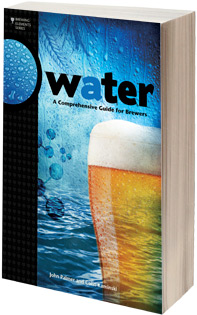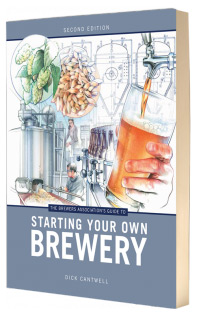 The Saint Louis Brewery Tap Room, the brewpub where Schlafly beers were first brewed, at this moment serves a beer called Optic Golden Ale. It was made with floor malted Optic barley grown in Scotland and Aramis and Strisselspalt hops from the Alsace region of France.
The Saint Louis Brewery Tap Room, the brewpub where Schlafly beers were first brewed, at this moment serves a beer called Optic Golden Ale. It was made with floor malted Optic barley grown in Scotland and Aramis and Strisselspalt hops from the Alsace region of France.
Will The Oxford Companion to Beer provide further detail?1
Indeed, the book delivers. You can look up:
– Floor malting.
– French hops.
– Optic (barley).
– Strisselspalt (hop).
Additionally, the index indicates the entry about Kronenbourg Brewery has information about Strisselspalt.
One question. Four (or five) answers. The Companion’s breadth is apparent. Upon further reading, however, a question arises. On page 377, the French hops entry states, “Strisselspalt is the region’s main cultivar, but its origins are rather obscure.” On page 522, the Kronenbourg entry states, “The flagship brand is Kronenbourg 1664 . . . brewed with Alsace’s native Strisselspalt hops.” And on page 772, the Strisselspalt entry states, “Its profile resembles Hersbrucker Spät [from Bavaria], also a landrace, from which Strisselspalt is thought to be derived.”
To recap: a) it’s native to the Alsace, or b) it’s the child of a Bavarian hop or c) nobody knows. Which is it?
Within its own pages The Companion includes contradictions that undermine the notion it is as authoritative as it is comprehensive. A reader doesn’t need to know much about beer or have visited the OCBeerCommentary to come to that conclusion. This is disappointing because, at least within the niche inside of a niche I sometimes find myself, it has changed the conversation.
The Companion does an excellent job of telling the story of beer today. It can provoke fireside-beer-sipping contemplation. It provides ideas to take to the pub for further debate. To repeat myself, the breadth is impressive. So is the academic rigor. At least most of the time. I think. Well, let me look that one up.
My apologies, but one quick personal story that addresses my personal bias. When I was 17 years old and working my first summer fulltime in the sports department at the Champaign-Urbana News-Gazette I filled out my work week by doing “rewrites.” That is typing handwritten missives from correspondents in outlying small towns. Mostly news about upcoming church picnics, who was entering what in the county fair and upcoming high school reunions.
Bill Schmelzle was the city editor and he scared me a bit. Maybe it was the cane, or that I sensed he didn’t like mistakes. One Sunday afternoon not long after I started we were alone in the newsroom. It was hot, the windows were open and he wasn’t wearing a shirt. This made him even more intimidating.
He held up a sheet of newsprint. He asked if I used the slug “hiero” on the rewrites I typed. What was I going to do, say I didn’t? I gulped and said yes. “Did you check the names?” he asked. I went to look for the handwritten copy. No, he said, against the phone books in the office “library.” The rest of the summer you can be sure I was going say yes if I was asked that question again.
A few years later I became city editor. This was a long time ago, when stories were cast in lead on linotype machines, proofs were drawn and people who worked in typesetting read the proofs. Most of them were women who could have been my grandmother, who lived in the surrounding small towns and otherwise might have been the correspondents whose work I typed up. One time one of them came out to the city desk. She explained to me that she was tired of correcting a particular name that kept popping into the news. Turns out we were checking it against the phone book. Problem is the phone book was wrong. She knew this because he was her neighbor.
Mistakes happen, and when you are writing a book they happen in ways that you can’t imagine. Something might have been correct the first 54 times you looked at it, a well meaning editor “corrected” it and you just didn’t read it carefully the 55th time. But in a book of this weight shouldn’t somebody have noticed? Not just little stuff, but big, and big picture.
The conversation changes.
It doesn’t change for those unaware of the book’s shortcomings. That’s not altogether bad, because at its best this is a damn fine book. Just not one that should be appearing in the footnotes of somebody’s doctoral thesis.
*****
One more aside, about the OCBeerCommentary. In order for it to have “value” you really need to own the book. And, in fact, it does have additional value beyond correcting errors. Alan McLeod noted at the outset he hoped contributors would add detail that goes beyond the book, and they have. It’s also interesting that there was chatter early about the rate of pay for entries. And now those just interested in seeing beer history “done right” are putting in considerable effort for no pay.2
1 In case you were wondering, this is not a set up. When I drank the beer I thought, “I wonder was The Companion might tell be about this.” I didn’t look for examples until I found one that suit my purposes. Although I’m not above that.
2 It’s also been suggested it would be best to wait for the next edition (three years or more). In fact, Oxford could clean up a ton of inconsistencies and small fact errors by making the sort of changes that are easily done from from one printing to the next. Hope they send Alan a thank you card.
 This can’t be coincidence. Today we have:
This can’t be coincidence. Today we have: Chuck Lenatti at Allbrews hosts
Chuck Lenatti at Allbrews hosts 

